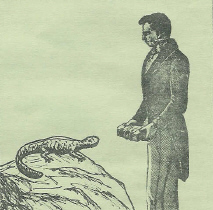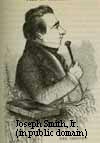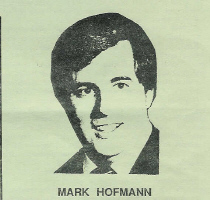Curse Tablet
who believe
Events in the Mark
Hofmann Case
March
1984:
LDS Bishop Steven Christensen confirms existence of the "Salamander
Letter," which he had purchased from Mark Hofmann, a document dealer, for $45,000 (some
accounts say $40,000) the previous January. This letter, which later turned out to be a forgery, was presented as being written by Martin Harris, one
 of the "Three Witnesses" whose names and testimonies appear in the front of every Book of Mormon. Harris was also the person who financed the original printing of the BoM. The letter purports to speak of Joseph Smith's
dealings with a magical salamander that appeared when he was trying to dig up the "golden plates" that were supposedly the source of the BoM, thereby showing Smith's involvement in occult practices. Although the Salamander Letter was a forgery, many
genuine documents and testimonies establish Smith's association with the occult.
The LDS church, believing it to be genuine (since the higher authorities knew
about Smith's early dealings in magic and deceptions), desired to suppress the
document. To that end, Bishop Christensen was told to buy the document and then turn it over to the LDS authorities so that it would never be published.
of the "Three Witnesses" whose names and testimonies appear in the front of every Book of Mormon. Harris was also the person who financed the original printing of the BoM. The letter purports to speak of Joseph Smith's
dealings with a magical salamander that appeared when he was trying to dig up the "golden plates" that were supposedly the source of the BoM, thereby showing Smith's involvement in occult practices. Although the Salamander Letter was a forgery, many
genuine documents and testimonies establish Smith's association with the occult.
The LDS church, believing it to be genuine (since the higher authorities knew
about Smith's early dealings in magic and deceptions), desired to suppress the
document. To that end, Bishop Christensen was told to buy the document and then turn it over to the LDS authorities so that it would never be published.
Jan. 1985: Jerald Tanner, in the
Salt Lake City Messenger (SLCM), presented a long argument about why the
Salamander Letter and the 1873 Martin Harris letter (both obtained from Hofmann) did not look authentic.(1) The LDS church declared
the Salamander Letter as "almost certainly authentic," as quoted in
the Deseret News.(2) Gordon Hinckley accepted the judgment of the examiner: "No one, of course, can be certain that Martin Harris wrote the document. However, at this point we accept the judgment of the exmainer that there is no indication of forgery. This does not preclude the possibility that it may have been forged at a time when the Church had many enemies."(3) Hinckley was a member of the "Quorum of the Twelve Apostles" of the LDS church. He became the church's president in 1995, a position which he held until his death in 2008. As president, he was officially known as the prophet, seer, and revelator of the church. Hinckley had
personally bought two documents from Hofmann, one for $15,000 and one for $25,000.(4)
After publication of Gerald Tanner's doubts about the Salamander Letter, Hofmann came to the
Tanners' house and said he was hurt that they were casting doubts on the
letters.(5)
One of the forged documents purchased by
Hinckley was a letter, allegedly from Joseph Smith. Hinckley paid $15,000 for this document.(6) Hofmann said Hinckley
told him the letter "would never see the light of day again." The
church exchanged valid documents for Hofmann's forgeries.(7)
"The Prophet Will Never Lead the Church
Astray" said Ezra Taft Benson, president of the church from 1985 to 1994.(8) Yet Mark Hofmann led astray the LDS
leaders. Hofmann said that he may have been trying to change the history of the
LDS church.(9)
This was suggested earlier by Jerald Tanner.

Hofmann decided to exploit a weakness that he
perceived in the Mormon leadership: "that they were trying to hide the
true history of the church from their people."(10) He thought the church
leaders were "easy marks" for his blackmailing by means of forgeries.
"His modus operandi was to profess great loyalty for the church
leaders while he was in reality stabbing them in the back."
The purpose of Steven Christensen in purchasing
the Salamander Letter was so it could be suppressed.(11) Christensen was very
incensed when the Tanners published parts of it. The sale of the Salamander
letter set the stage for Hofmann to try sell the McLellin Collection, a series
of documents by one of the early Mormons who was well acquainted
with Joseph Smith, but whose writings had somehow been lost in the course of time. McLellin was one of the original members of the Quorum of Twelve Apostles. The church prompted one of its wealthy members to offer Hofmann $185,000 to try to obtain the McLellin Collection so it could never be made public.
In the Book of Mormon, Amulek
had power of discernment to catch someone in a lie (Alma 10:17), as did Nephi in Heleman
9:25-41. So did Peter regarding Ananias and Sapphira.(12) Mormon leaders have
claimed that they have all the power, discernment, and authority of the
original apostles.
October 1985: Hofmann murdered
Bishop Steven Christensen and Kathleen Sheets with package bombs. A third bomb
exploded in Hofmann's car. It may have been intended for the Tanners.
Detective Jim Baker, a chief investigator of the
murders, said of the "cooperation" he got from LDS leadership:
"They're hiding something; the church is doing everything it can to make
this as difficult as possible. I've never seen anything like this in a homicide
investigation." (13)

1992: In response to several
books about the Hofmann murders which were very damaging to the LDS hierarchy,
Richard Turley, Managing Director of the Church Historical Department, wrote a
book attempting to absolve the LDS leaders in their handling of the Hofmann
affair.(14)
Nevertheless the book includes this bombshell: The church had an important part
of the McLellin Collection in the First Presidency vault, where it had been
since 1908. Church officials became aware of this in March 1986, according to Turley. At this time the government was trying to gather evidence to build its case against Hofmann.
The church faced a dilemma: if they admitted they had the McLellin
papers all along, it would prove the charge that the church suppresses
historical information and important documents. On the other hand, the
existence of the collection would be a great help to investigators in their
case against Mark Hofmann. It would have given the motive for the murders:
Hofmann did not have the collection to give to Christensen on the day appointed
for their delivery. This was made known to Richard Turley, to Apostle Dallin Oaks, who had been a member of the Utah Supreme Court, and to members of the First Presidency, including Gordon Hinckley. Although the first two of these were trained as lawyers, no one revealed the existence of the collection to the prosecution to help them prepare their case for the coming trial of Hofmann. It was not until Turley's book was published six years later that this information came out.
February 1986: Apostle Dallin Oaks expressed
doubts that the prosecution case was strong enough to convict Hofmann. (15) This is according to
Turley's book, p. 243. This makes very culpable Oaks' action in not disclosing
that the church had the McLellin Collection when it was found in the next
month. This would have provided the motive the FBI needed to successfully convict Hofmann.
The church's hiding of this knowledge allowed a murderer (Hofmann) to plead for, and obtain, a plea bargain rather than having a court trial in which President Hinckley would have to testify. Further, if there was a court trial and the existence of the McLellin Papers in the First Presidency's vault was made known, the the prosecuting attorney would surely have asked that the Papers be subpoenaed. The Church wanted to avoid that at all costs because McCLellin's Papers would shed too much light on Joseph Smith and early Mormonism.
As it was, since the existence of the McLellin Collection was
hidden from the investigating authorities, the prosecution settled for a plea bargain that
avoided a trial and the possibility of a death penalty for Hofmann. As a reporter for the Los Angeles Times remarked: "What a nice plea bargain. In any other state you'd see this thing go on trial, because that's how prosecutors' reputations are made. Going to trial and getting bad guys, big splashes, lots of exposure. Here you have a nice plea bargain." The LDS
hierarchy gained a lot by the plea bargain: Gordon Hinckley was never called
to testify, and they were spared the embarrassment that cross-questioning would
have produced regarding the church's consistent cover-ups, stonewalling, and
hiding of documents. It would also reveal that Hoffman had utterly fooled the
LDS Church authorities into purchasing thousands of dollars worth of forged
documents because of their fear lest the early history of Mormonism should be made known.
The plea bargain was therefore a victory for the LDS
church, and one has to wonder if it wasn't brought about by undue influence of
the church in the legal processes of the state of Utah.
In all, however, the Hofmann affair has
greatly damaged the credibility of the Mormon church with many people. And if
they are so open about everything as they claim to be, why don't they publish
the McLellin papers? To this day they sit hidden in the vault of the First Presidency, where they have been since 1908, hidden from the eyes of anyone who wanted to know what one of Joseph Smith's closest associates said about him and about the policies of the Mormon leadership in the earliest period.
"Mormon Apostle Bruce R. McConkie
proclaimed that church leaders have the gift of discernment: "...the gift
of the discerning of spirits is poured out upon presiding officials in God's
kingdom; they have it given to them to discern all gifts and all spirits, lest
any come among the saints and practice deception...""(16) If this had been true
of the church's leaders, they would have seen the character of Hofmann's
deception. Yet despite repeated meetings with him, none of them saw through it,
and the chain of events led to the murder of two persons. Hofmann even met with
Apostle Dallin Oaks just hours after Hofmann killed Steven Christensen and
Kathleen Sheets, and Oaks still believed Hofmann was an honest friend.
The apostles of the church were therefore deceived regarding Mark Hofmann's character and his forged
documents. These were not just any historical documents--they were documents dealing with the doctrines and "revelations" foundational to Mormonism (but, of course, not foundational to genuine Christianity). Since Mormon leaders were fundamentally wrong and deceived regarding the character of Mark Hofmann and his documents that dealt with the basis of their church, could they also be fundamentally wrong and deceived about Joseph Smith's character and his documents?
For more information about the Mark Hofmann
murders and the multiple deceptions involved (Hofmann's of the LDS church
leadership, and the LDS leadership's repeated deceptions of government
investigators, the news media, and the general public), see the "Mark Hofmann" entry
in Wikipedia.
+=+=+=+=+=+=+=+=+=+=+=+=+=+=+=+=+=+=+=+=+=+=
(1) Salt
Lake City Messenger (hereinafter SLCM), Salt Lake City, UT: Utah Lighthouse
Ministry, No. 55 (January 1985) pp. 1-13. This issue and issue 57 are not
available online.
(2) Deseret News for April 28,
1985, article "1830 Harris letter authenticated."
(3) SLCM
57 (June 1985) p. 12.
(4) SLCM
115, (October 2010) p. 5. This and the issues of SLCM subsequently cited are
online. The HTML version does not include page numbers, while the PDF version does. To access issue 115, click here.
(5) SLCM
58 (January 1986) p. 4. For online version, click here.
(6) SLCM 83 (November 1992) p. 3. For online version, click here.
(7) SLCM 61 (October 1986) p. 9. For online version, click here.
(8)
Ibid. p. 13.
(9)
SLCM 64 (September 1987) p. 5. For online version, click here.
(10)
Ibid., p. 7.
(11)
Ibid., p. 12.
(12)
Ibid., p. 18.
(13)
SLCM 70 (January 1989) p. 12. For online version, click here.
(14) SLCM 83 (cited above), p. 2. Richard
Turley's book is Victims: The LDS Church and the Mark Hofmann Case
(Univ. of Illinois Press, 1992).
(15)
Ibid., p. 7.
(16)
Ibid., p. 12.